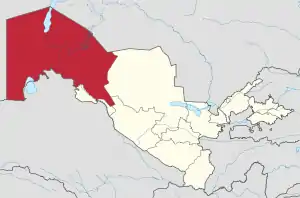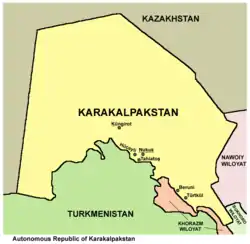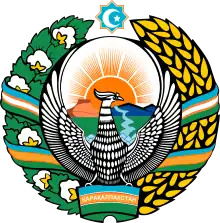Republic of Karakalpakstan Qaraqalpaqstan Respublikası / Қарақалпақстан Республикасы (Karakalpak) Qoraqalpogʻiston Respublikasi / Қорақалпоғистон Республикаси (Uzbek) | |
|---|---|
| Motto: Jayxun jaģasında ósken bayterek (Karakalpak) | |
| Anthem: Qaraqalpaqstan Respublikasınıń Mámleketlik Gimni (Karakalpak) "State Anthem of the Republic of Karakalpakstan" | |
 Karakalpakstan in Uzbekistan | |
| Sovereign state | Uzbekistan |
| Capital | Nukus |
| Official languages | |
| Ethnic groups (2022[1]) |
|
| Government | |
| Amanbai Orynbaev | |
| Farkhat Ermanov | |
| Legislature | Supreme Council of Karakalpakstan |
| Area | |
• Total | 166,590 km2 (64,320 sq mi) |
| Population | |
• 2023 estimate | 1,923,734 |
• Density | 11.55/km2 (29.9/sq mi) |
| Time zone | UTC+5:00 (Uzbekistan Standard Time) |
Karakalpakstan,[lower-alpha 1] officially the Republic of Karakalpakstan,[lower-alpha 2] is an autonomous republic of Uzbekistan. It occupies the whole northwestern part of Uzbekistan. The capital is Nukus (Nókis / Нөкис). Karakalpakstan covers an area of 166,590 km2 (64,320 sq mi),[2] and a population of about 2 million people. Its territory covers the classical land of Khwarezm, which in classical Persian literature was known as Kāt (کات).
The name Karakalpakstan means "land of the Karakalpaks". Although most Karakalpaks reside in Uzbekistan, Karakalpak culture and language are closer to those of the Kazakhs and Noghais.[3]
History
.jpg.webp)
From about 500 BC to 500 AD, the region of what is now Karakalpakstan was a thriving agricultural area supported by extensive irrigation.[4] It was strategically important territory and fiercely contested, as is seen by the more than 50 Khorezm Fortresses which were constructed here. The Karakalpak people, who used to be nomadic herders and fishers, were first recorded by foreigners in the 16th century.[5] Karakalpakstan was ceded to the Russian Empire by the Khanate of Khiva in 1873.[6] Under Soviet rule, it was an autonomous area within the Russian Soviet Federative Socialist Republic before becoming part of Uzbekistan in 1936 as the Karakalpak ASSR.[7] The region was probably at its most prosperous in the 1960s and 1970s, when irrigation from the Amu Darya was being expanded. However, the evaporation of the Aral Sea has made Karakalpakstan one of Uzbekistan's poorest regions.[5] The region is suffering from extensive drought, partly due to climate patterns, but also largely because the Amu Darya and Syr Darya rivers are mostly diverted in the eastern parts of Uzbekistan. Crop failures have deprived about 48,000 people of their main source of income and shortages of potable water have created a surge of infectious diseases.[8]
Geography
Karakalpakstan is now mostly desert and is located in western Uzbekistan near the Aral Sea, in the lowest part of the Amu Darya basin.[9][8][10] It has an area of 164,900 km2[11] and is surrounded by desert. The Kyzyl Kum Desert is located to the east and the Karakum Desert is located to the south. A rocky plateau extends west to the Caspian Sea.[4]
Politics
Autonomous status
Its predecessor, the Karakalpak Autonomous Soviet Socialist Republic, was an autonomous republic in the Soviet Union until its incorporation into the Uzbek Soviet Socialist Republic in 1932. The Republic of Karakalpakstan maintained its predecessor's formal sovereignty, even after the independence of Uzbekistan in 1990.[12] Karakalpakstan shares veto power with Uzbekistan over decisions concerning its affairs. According to the constitution, relations between Karakalpakstan and Uzbekistan are "regulated by treaties and agreements" and any disputes are "settled by way of reconciliation". Its right to secede is limited by the veto power of Uzbekistan's legislature over any decision to secede.[11] Article 74, chapter XVII, Constitution of Uzbekistan, provides that: "The Republic of Karakalpakstan shall have the right to secede from the Republic of Uzbekistan on the basis of a nationwide referendum held by the people of Karakalpakstan."
In July 2022, large protests broke out in the region over a proposed constitutional change which would strip Karakalpakstan of its autonomy.[13][14] The proposed change was later scrapped in response to the demonstrations.[15]
Leadership
The head of the republic is the Chairman of the Parliament (known as the "President of the Republic" from 1991 to 1992). The head of the government is the Chairman of the Council of Ministers, who heads the Karakalpak Council of Ministers.
One of the deputy chairmen of the Senate of the Oliy Majlis is a representative of Karakalpakstan as per the constitution.
Demographics
The population is estimated 1,948,488 (2022), with 51% living in rural areas.[16][17] In 2007 it was estimated that about 400,000 of the population are of the Karakalpak ethnic group, 400,000 are Uzbeks and 300,000 are Kazakhs.[5] Though 95% of Karakalpaks reside in Uzbekistan,[18] mostly in Karakalpakstan, the Karakalpak language is closer to Kazakh than to Uzbek.[19] The language was written in a modified Cyrillic in Soviet times and has been written in the Latin alphabet since 1996.
Other than the capital Nukus, major cities include Xojeli, Taqiyatas, Shimbay, Qońirat (Kungrad) and Moynaq.
The crude birth rate is 2.2%: approximately 39,400 children were born in 2017. Nearly 8,400 people died in the same period. The crude death rate is 0.47%. The natural growth rate is 31,000, or 1.72%.
The median age was 27.7 years old in 2017, which is younger than the rest of Uzbekistan (median age of 28.5 countrywide). Men are 27.1 years old, while women are 28.2 years old.
Dynamics of the number and ethnic composition of the population of Karakalpakstan according to the All-Union censuses of 1926–1989:
| Nationality | 1926 (people) | % | 1939 (people) | % | 1959 (people) | % | 1970 (people) | % | 1979 (people) | % | 1989 (people) | % |
|---|---|---|---|---|---|---|---|---|---|---|---|---|
| Total | 304 539 | 100.00% | 469 702 | 100.00% | 510 101 | 100.00% | 702 264 | 100.00% | 905 500 | 100.00% | 1 212 207 | 100.00% |
| Uzbeks | 84 099 | 27.62% | 116 054 | 24.71% | 146 783 | 28.78% | 212 597 | 30.27% | 285 400 | 31.52% | 397 826 | 32.82% |
| Karakalpaks | 116 125 | 38.13% | 158 615 | 33.77% | 155 999 | 30.58% | 217 505 | 30.97% | 281 809 | 31.12% | 389 146 | 32.10% |
| Kazakhs | 85 782 | 28.17% | 129 677 | 27.61% | 133 844 | 26.24% | 186 038 | 26.49% | 243 926 | 26.94% | 318 739 | 26.29% |
| Turkmens | 9686 | 3.18% | 23 259 | 4.95% | 29 225 | 5.73% | 37 547 | 5.35% | 48 655 | 5.37% | 60 244 | 4.97% |
| Russians | 4924 | 1.62% | 24 969 | 5.32% | 22 966 | 4.50% | 25 165 | 3.58% | 21 287 | 2.35% | 19 846 | 1.64% |
| Koreans | 7347 | 1.56% | 9956 | 1.95% | 8958 | 1.28% | 8081 | 0.89% | 9174 | 0.76% | ||
| Tatars | 884 | 0.29% | 4162 | 0.89% | 6177 | 1.21% | 7619 | 1.08% | 7617 | 0.84% | 7767 | 0.64% |
| Ukrainians | 621 | 0.20% | 3130 | 0.67% | 2201 | 0.43% | 2316 | 0.33% | 2005 | 0.22% | 2271 | 0.19% |
| Bashkirs | 29 | 0.01% | 381 | 0.08% | 571 | 0.11% | 854 | 0.12% | 920 | 0.10% | 1090 | 0.09% |
| Kyrgyz | 277 | 0.09% | 181 | 0.04% | 177 | 0.03% | 400 | 0.06% | 1955 | 0.22% | 867 | 0.07% |
| Moldovans | 10 | 0.00% | 16 | 0.00% | 57 | 0.01% | 343 | 0.04% | 632 | 0.05% | ||
| Belarusians | 30 | 0.01% | 214 | 0.05% | 328 | 0.06% | 517 | 0.07% | 852 | 0.09% | 567 | 0.05% |
| other | 2072 | 0.68% | 1697 | 0.36% | 1874 | 0.37% | 2691 | 0.38% | 2650 | 0.29% | 4038 | 0.33% |
| Year | Pop. | ±% p.a. |
|---|---|---|
| 1979 | 904,315 | — |
| 1989 | 1,214,000 | +2.99% |
| 2000 | 1,503,000 | +1.96% |
| 2010 | 1,632,000 | +0.83% |
| 2020 | 1,898,351 | +1.52% |
| Source: Citypopulation[20] | ||
Economy

The economy of the region used to be heavily dependent on fisheries in the Aral Sea. It is now supported by cotton, rice and melons. Karakalpakstan is well known for its fruits, such as plums, pears, grapes, and apricots, in addition to all kinds of melons. Hydroelectric power from a large Soviet-built station on the Amu Darya is also important.
The Amu Darya delta was once heavily populated and supported extensive irrigation based agriculture for thousands of years. Under the Khorezm, the area attained considerable power and prosperity. However, the gradual climate change over the centuries, accelerated by human induced evaporation of the Aral Sea in the late 20th century has created a desolate scene in the region. The ancient oases of rivers, lakes, reed marshes, forests and farms are drying up and being poisoned by wind-borne salt and by fertilizer and pesticide residues from the dried bed of the Aral Sea. Summer temperatures have risen by 10 °C (18 °F) and winter temperatures have decreased by 10 °C (18 °F). The rate of anemia, respiratory diseases and other health problems has risen dramatically.[21]
Administrative divisions


The autonomous republic of Karakalpakstan consists of 16 districts (listed below) and one district-level city: Nukus (number 1 on map).[2]
Taqiyatas district was created in 2017 from part of Xojeli district.[22] Bozataw district was created in September 2019 from parts of the Kegeyli district and the Shimbay district.[23]
There are 12 cities (Nókis, Mańģit, Beruniy, Xaliqabat, Qońirat, Moynaq, Taqiyatas, Tórtkúl, Xojeli, Shimbay, Shomanay, Bostan) and 26 urban-type settlements in Karakalpakstan.[2][24]
Media
Radio
In 2009, the first radio station of Karakalpakstan was opened. The station is called Nukus FM, which broadcasts on radio frequency 100.4 MHz, only in Nukus.
See also
- Delta Blues (documentary film)
- Human rights in Uzbekistan
- Karakalpak Autonomous Oblast, a short-lived Soviet entity
- Karakalpak Autonomous Soviet Socialist Republic, an autonomous republic of the Russian Soviet Federative Socialist Republic and then the Uzbek SSR
- Mizdahkan
Explanatory notes
- ↑
- Karakalpak: Qaraqalpaqstan / Қарақалпақстан
- Uzbek: Qoraqalpogʻiston / Қорақалпоғистон
- ↑
- Karakalpak: Qaraqalpaqstan Respublikası / Қарақалпақстан Республикасы
- Uzbek: Qoraqalpogʻiston Respublikasi / Қорақалпоғистон Республикаси
References
- ↑ "Permanent population by national and / or ethnic group, urban / rural place of residence". Open Data Portal. Retrieved 14 April 2022.
- 1 2 3 "Oʻzbekiston Respublikasining maʼmuriy-hududiy boʻlinishi" [Administrative-territorial division of the Republic of Uzbekistan] (in Uzbek). The State Committee of the Republic of Uzbekistan on statistics. July 2021. Archived from the original on 4 February 2022.
- ↑ "Glottolog 4.8 - Kara-Kalpak". glottolog.org. Retrieved 31 October 2023.
- 1 2 Bolton, Roy (2009). Russian Orientalism: Central Asia and the Caucasus. Sphinx Fine Art. p. 54. ISBN 978-1-907200-00-7. Archived from the original on 16 April 2021. Retrieved 3 March 2012.
- 1 2 3 Mayhew, Bradley (2007). Central Asia: Kazakhstan, Tajikistan, Uzbekistan, Kyrgyzstan, Turkmenistan. Lonely Planet. p. 258. ISBN 978-1-74104-614-4. Archived from the original on 16 April 2021. Retrieved 3 March 2012.
- ↑ Richardson, David; Richardson, Sue (2012). Qaraqalpaqs of the Aral Delta. Prestel Verlag. p. 68. ISBN 978-3-7913-4738-7.
- ↑ Europa Publications Limited (2002). Eastern Europe, Russia and Central Asia. Taylor & Francis. p. 536. ISBN 1-85743-137-5. Archived from the original on 16 April 2021. Retrieved 3 March 2012.
- 1 2 Thomas, Troy S.; Kiser, Stephen D.; Casebeer, William D. (2005). Warlords rising: confronting violent non-state actors. Lexington Books. pp. 30, 147–148. ISBN 0-7391-1190-6. Archived from the original on 16 April 2021. Retrieved 3 March 2012.
- ↑ Batalden, Stephen K.; Batalden, Sandra L. (1997). The newly independent states of Eurasia: handbook of former Soviet republics. Greenwood Publishing Group. p. 187. ISBN 0-89774-940-5. Archived from the original on 16 April 2021. Retrieved 3 March 2012.
- ↑ Merkel, Broder; Schipek, Mandy (2011). The New Uranium Mining Boom: Challenge and Lessons Learned. Springer. p. 128. ISBN 978-3642221217. Archived from the original on 16 April 2021. Retrieved 7 June 2012.
- 1 2 Roeder, Philip G. (2007). Where nation-states come from: institutional change in the age of nationalism. Princeton University Press. pp. 55, 67. ISBN 978-0-691-13467-3. Archived from the original on 16 April 2021. Retrieved 3 March 2012.
- ↑ Rickleton, Chris (1 February 2023). "In Uzbekistan's Karakalpakstan, Trial Over Deadly Unrest Makes A 'Hero' Of Its Intended Villain". Radio Free Europe/Radio Liberty. Retrieved 5 April 2023.
- ↑ "Uzbekistan's new constitution: More for Mirziyoyev, less for Karakalpakstan". eurasianet.org. Archived from the original on 2 July 2022. Retrieved 1 July 2022.
- ↑ "Жители Узбекистана вышли на митинги после конституционной реформы". www.kommersant.ru (in Russian). 1 July 2022. Archived from the original on 1 July 2022. Retrieved 1 July 2022.
- ↑ "Uzbekistan scraps plans to curb Karakalpak autonomy after protest". Reuters. 2 July 2022. Archived from the original on 2 July 2022. Retrieved 2 July 2022.
- ↑ "O'zbekistonda eng ko'p aholi qaysi viloyatda yashaydi?". Qalampir.uz (in Uzbek). Archived from the original on 5 July 2022. Retrieved 10 February 2022.
- ↑ "Urban and rural population by district" (PDF) (in Kara-Kalpak). Karakalpakstan Republic department of statistics. Archived from the original on 5 July 2022. Retrieved 9 February 2022.
- ↑ Birgit Schlyter (2012). "Language Policy and Language Development in Multilingual Uzbekistan". In Schiffman, Harold (ed.). Language Policy and Language Conflict in Afghanistan and Its Neighbors. Brill. p. 191. ISBN 978-90-04-21765-2.
- ↑ Karakalpakstan: Uzbekistan's latent conflict Archived 4 March 2016 at the Wayback Machine, 6 January 2012
- ↑ "Uzbekistan: Provinces". Archived from the original on 31 March 2022. Retrieved 12 March 2022.
- ↑ Pearce, Fred (2007). When the Rivers Run Dry: Water, the Defining Crisis of the Twenty-first Century. Beacon Press. p. 211. ISBN 978-0-8070-8573-8. Archived from the original on 16 April 2021. Retrieved 28 November 2020.
- ↑ "New Takhiatash region formed in Karakalpakstan" (in Russian). 14 August 2017. Archived from the original on 23 June 2018.
- ↑ "About creation of Boʻzatov district of the Republic of Karakalpakstan" (in Uzbek). 5 September 2019. Archived from the original on 24 February 2021. Retrieved 5 February 2022.
- ↑ "Classification system of territorial units of the Republic of Uzbekistan" (in Uzbek and Russian). The State Committee of the Republic of Uzbekistan on statistics. July 2020. Archived from the original on 6 January 2022. Retrieved 5 February 2022.


